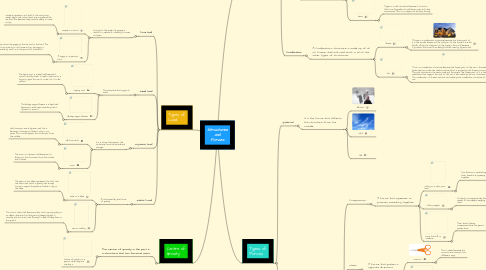
1. Types of Load
1.1. Live load
1.1.1. Live load is the weight of people or item(s) in a vehicle or a building. It comes and goes.
1.1.1.1. People in a school
1.1.1.1.1. Students, teachers, and staff in the school are weight held in the school which are considered the live load. Also because they have the ability to come and go.
1.1.1.2. A Puppy on a person's hand
1.1.1.2.1. This picture shows the puppy as the live load on the hand. The puppy can hop around run and come and go; the puppy is not a permanently stuck onto the ground or the earth's surface.
1.2. Dead load
1.2.1. The structure that supports itself.
1.2.1.1. Laptop cart
1.2.1.1.1. The laptop cart is a dead load because it cannot move by itself, it needs a live load or a force to push the cart in order for it to be shifted.
1.2.1.2. Bridge support beams
1.2.1.2.1. The bridge support beams is a dead load because it would need something that is dynamic to move it.
1.3. Dynamic load
1.3.1. It is a force that impacts the structure from the outside and changes.
1.3.1.1. Wind currents
1.3.1.1.1. Wind currents are a dynamic load, this is because it changes and doesn't stay in one place. Also it would impact the structures from the outside.
1.3.1.2. Snow
1.3.1.2.1. The snow is a dynamic load because it is blowing on the structure from the outside and it moves.
1.4. Static Load
1.4.1. A load caused by the force of gravity.
1.4.1.1. Plate on a table
1.4.1.1.1. The plate on the table represents the fact that the static load, which is gravity has enough force to impact the plate and make it stay on the table.
1.4.1.2. Person walking
1.4.1.2.1. This shows static load, because static load is gravity pulling on an object downward and the person keeping upright is showing that the static load, (Gravity) is able to keep them on the ground.
2. Centre of Gravity
2.1. The centre of gravity is the part in a structure that has the most mass.
2.1.1. Centre of gravity on a person while they are standing is
3. Types of Structures
3.1. Frame
3.1.1. Frame structure is what supports the shell structure and often supports generally just the entire structure itself.
3.1.1.1. Roller Coaster
3.1.1.1.1. A roller coaster is a frame structure, because it's made of many different parts that are fastened together and it is built like a skeleton.
3.1.1.2. Eiffel Tower
3.1.1.2.1. 2
3.2. Shell
3.2.1. Shell structure is light and hollow inside.
3.2.1.1. Egg Shell
3.2.1.1.1. This is a frame structure because it is hollow inside, and is very light by itself. Also the egg white and egg yolk inside it is protected by it.
3.2.1.2. Igloo
3.2.1.2.1. The igloo is a frame structure because it is hollow inside and the people that are inside are using the structure as a shelter. Therefore, it is a frame structure.
3.3. Solid
3.3.1. A solid structure is compact all the way through.
3.3.1.1. Eraser
3.3.1.1.1. An eraser is a solid structure because it is solid all the way through when you use it.
3.3.1.2. Gems
3.3.1.2.1. A gem is a solid structure because it is hard so that it can be made into necklaces, rings and other accessories. Also it is compact all the way through.
3.4. Combination
3.4.1. A Combinations structure is made up of all of frame, shell and solid which is all of the other types of structures.
3.4.1.1. House
3.4.1.1.1. A house is a combination structure because the frame part of it is the wooden beams and the solid part of the house is are the bricks. Finally, the shell part of the house is the roof because it protects the house from being knocked over by dynamic load.
3.4.1.2. Car
3.4.1.2.1. A car is a combination structure because the frame part of the car is the metal plates that are under the shell structure which is protecting the frame structure. The solid structure is the seats inside and the engine. The frame part of it is the metal bars that support the rest of the car, It also make up the car structure. This combination of frame, shell and solid make up the combination structure of the car.
4. Types of Forces
4.1. External
4.1.1. It is the force that affects the structure from the outside.
4.1.1.1. Blizzard
4.1.1.2. Wind
4.1.1.3. Hail
4.2. Internal
4.2.1. Is a force that is created from within the structure.
4.2.1.1. Compression
4.2.1.1.1. A force that squeezes or presses something together.
4.2.1.2. Shear
4.2.1.2.1. A force that pushes in opposite directions.
4.2.1.3. Tension
4.2.1.3.1. A force that stretches apart to expand.
4.2.1.4. Torsion
4.2.1.4.1. A force that twists.

